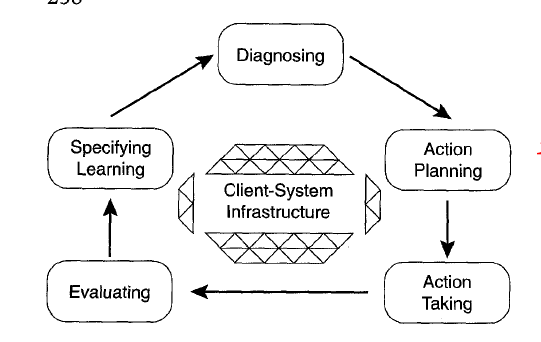Lesson Introduction
In the previous lesson, we discussed the process of action research briefly. In this lesson, models of action research will be discussed. In addition, a model that developed based on the analysis of various models will be introduced as the course model to guide the development of course project. You will also be asked to draft your purpose statement and research questions based on your “desire of change”.
Models of Action Research
According to Fraenkel & Wallen (2009) the scientific research method includes five steps: 1) Identifying a problem or question, 2) Clarifying the problem, 3) Determining the information needed and how to obtain it, 4) Organizing the information, and 5) Interpreting the results. These five steps can also be described as: 1) identify a focus, 2) diagnose a problem, 3) data collection, 4) data analysis, and 5) interpret the result. When an intervention is included, then planning and implementing the intervention should be added to the process. In addition, clarifying or diagnose a specific research problem should normally include the review of literature. (A literature review is a critical and in depth evaluation of previous research. It is a summary and synopsis of a particular area of research, allowing anybody reading the paper to establish why you are pursuing this particular research program. A good literature review expands upon the reasons behind selecting a particular research. If you want to read more about literature review please check: http://www.writing.utoronto.ca/advice/specific-types-of-writing/literature-review )
Therefore, after adding Planning an Intervention, Implementing and Intervention, and Literature review to the process of scientific research, the traditional intervention research can be represented by the following model:

Figure 1. The process of an intervention research
This model shows a linear research process. Action research, however, is a cyclical process. Most descriptions of action research stress its cyclical or spiral nature. It keeps evolving on its previous findings for desirable results. Although it is believed that the process of action research is the same, the process of action research has been elaborated in different representations – different models (Waters-Adams, 2006). The following are some of these models.
Kemmis and McTaggart (1982) suggested a four step model of action research (see figure 2). On the right to figure 2 is the simplified Kemmis and McTaggart’s model. We can see, this model emphasizes the cyclical nature of action research. Each cycle has four steps: 1) plan, 2) act, 3) observe, and 4) reflect. Compared to Jack Whitehead’s (1985) model that we learned in last lesson, this model put a specific emphasis on reflection.


Figure 2. Kemmis and McTaggart's (1982) model ............................................................................. (simplified Kemmis Model)
In 1978, Susman and Evered suggested a more elaborated model of action research, which includes five phases in each research cycle: 1) diagnosing, 2) action planning, 3) action taking, 4) evaluating, and 5) specifying learning (see Figure 3). Except the first step, diagnosing, the other four steps are similar to the four steps in Kemmis and McTaggart’s model. This model is believed to be the most prevalent description of action research. It is also widely used in the organizational settings.

Figure 3. Susman and Evered’s model

Figure 4. Coughlan and Coghlan’s model
Figure 4 shows another model of action research that is suggested by Coughlan and Coghlan (2002). Their model elaborated the Phase of diagnosing in Susman’s model into three sub-phases:1) data gathering, 2) data feedback, and 3) data analysis. In addition, they put importance to the pre-step of action research - Context and Purpose, which is driven by questions that concerning the rationale for action research. In addition, a meta-step, monitoring, is also added to the model, which occurs through all the cycles.
Instead of choosing one of them as our course model, we decided to come out with our own model by comparing these models. For easier comparison, we re-drew the models to resemble the intervention research model that we discuss at the beginning of this section. The dashed boxes indicate the steps that are included in our intervention research model but not in the specific action research model.
1. Kemmis and McTaggart’s model

2. Susman’s model

3. Coughlan and Coghlan’s model

Coughlan and Coghlan’s divided step 2 - Diagnose a Problem - into three sub-steps: data collection, data feedback, and data analysis. In other words, it indicates that data collection and analysis could happen twice in action research instead of only one time on the step similar to Evaluating. In traditional research, problem diagnosing is normally through review of literature.
4. The following is another model that is adjusted from the action research processes suggested by Brighton (2009) and Capobianco & Joyal, (2008).

5. Our model of action research
After analyzing, comparing, and combining the above models, we came out with the following model (see Figure 5). In this class, we will use this model to guide the development of the class project. Our model includes one pre-phase and six major phases: 1) identify a focus, 2) diagnose a problem, 3) plan an action, 4) implement the action, 5) evaluate the action, 6) interpret the result, and 7) reflect. In Adapted from Coughlan and Coghlan’s model, our model also divides Diagnose a Problem into three sub-steps: Literature review, data collection, and data analysis. Although data collection and data analysis are included, they are not must-dos in action research. Whether these two steps are taken depend on the necessity of it in each specific research project. In most cases, literature review, informal interviews, or group discussions can do the work respectively.
From this model, you can see that you are now working on the first step, Identify a Focus. Because the limited class time, we will only work on one cycle of action research, that is, from step 1 – step 7.

Figure 5. Our model
